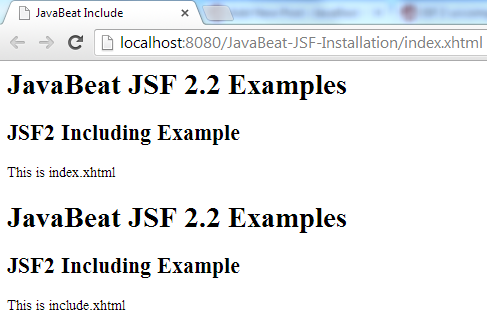Facelets was originally developed as an alternative to the JSP-based view handler in JSF1.x. In JSF 2.0 facelets replaces JSP as JSF’s default view technology. In addition to being a better view handler, Facelets supports a number of tags and one of them is a tag for including content from other XHTML pages.
Also Read:
1. The View
index.xhtml
<html xmlns="http://www.w3.org/1999/xhtml" xmlns:ui="http://java.sun.com/jsf/facelets" xmlns:h="http://java.sun.com/jsf/html" xmlns:f="http://java.sun.com/jsf/core" xmlns:c="http://java.sun.com/jsp/jstl/core"> <h:head> <title><h:outputText value="JavaBeat Include"/></title> </h:head> <h:body> <h:form id="form"> <h1><h:outputText value="JavaBeat JSF 2.2 Examples" /></h1> <h2><h:outputText value="JSF2 Including Example" /></h2> <h:outputText value="This is index.xhtml"/> <ui:include src="/include.xhtml"/> </h:form> </h:body> </html>
include.xhtml
<html xmlns="http://www.w3.org/1999/xhtml" xmlns:ui="http://java.sun.com/jsf/facelets" xmlns:h="http://java.sun.com/jsf/html" xmlns:f="http://java.sun.com/jsf/core" xmlns:c="http://java.sun.com/jsp/jstl/core"> <h:head> <title><h:outputText value="JavaBeat Include"/></title> </h:head> <h:body> <h:form id="form"> <h1><h:outputText value="JavaBeat JSF 2.2 Examples" /></h1> <h2><h:outputText value="JSF2 Including Example" /></h2> <h:outputText value="This is include.xhtml"/> </h:form> </h:body> </html>
2. The Deployment Descriptor (web.xml)
web.xml
<?xml version="1.0" encoding="UTF-8"?> <web-app xmlns:xsi="http://www.w3.org/2001/XMLSchema-instance" xmlns="http://java.sun.com/xml/ns/javaee" xmlns:web="http://java.sun.com/xml/ns/javaee/web-app_2_5.xsd" xsi:schemaLocation="http://java.sun.com/xml/ns/javaee http://java.sun.com/xml/ns/javaee/web-app_2_5.xsd" id="WebApp_ID" version="2.5" metadata-complete="true"> <context-param> <description>State saving method: 'client' or 'server' (=default). See JSF Specification 2.5.2 </description> <param-name>javax.faces.STATE_SAVING_METHOD</param-name> <param-value>client</param-value> </context-param> <context-param> <param-name>javax.faces.application.CONFIG_FILES</param-name> <param-value>/WEB-INF/faces-config.xml</param-value> </context-param> <servlet> <servlet-name>Faces Servlet</servlet-name> <servlet-class>javax.faces.webapp.FacesServlet</servlet-class> <load-on-startup>1</load-on-startup> </servlet> <servlet-mapping> <servlet-name>Faces Servlet</servlet-name> <url-pattern>/faces/*</url-pattern> </servlet-mapping> <servlet-mapping> <servlet-name>Faces Servlet</servlet-name> <url-pattern>*.xhtml</url-pattern> </servlet-mapping> <listener> <listener-class>com.sun.faces.config.ConfigureListener</listener-class> </listener> </web-app>
3. JSF 2 Include Demo
The below snapshot shows you the proper use of ui:include to include the content of another XHTML.

[wpdm_file id=23]

 JSF 2 Template – Composition, Insert and Define Example
JSF 2 Template – Composition, Insert and Define Example